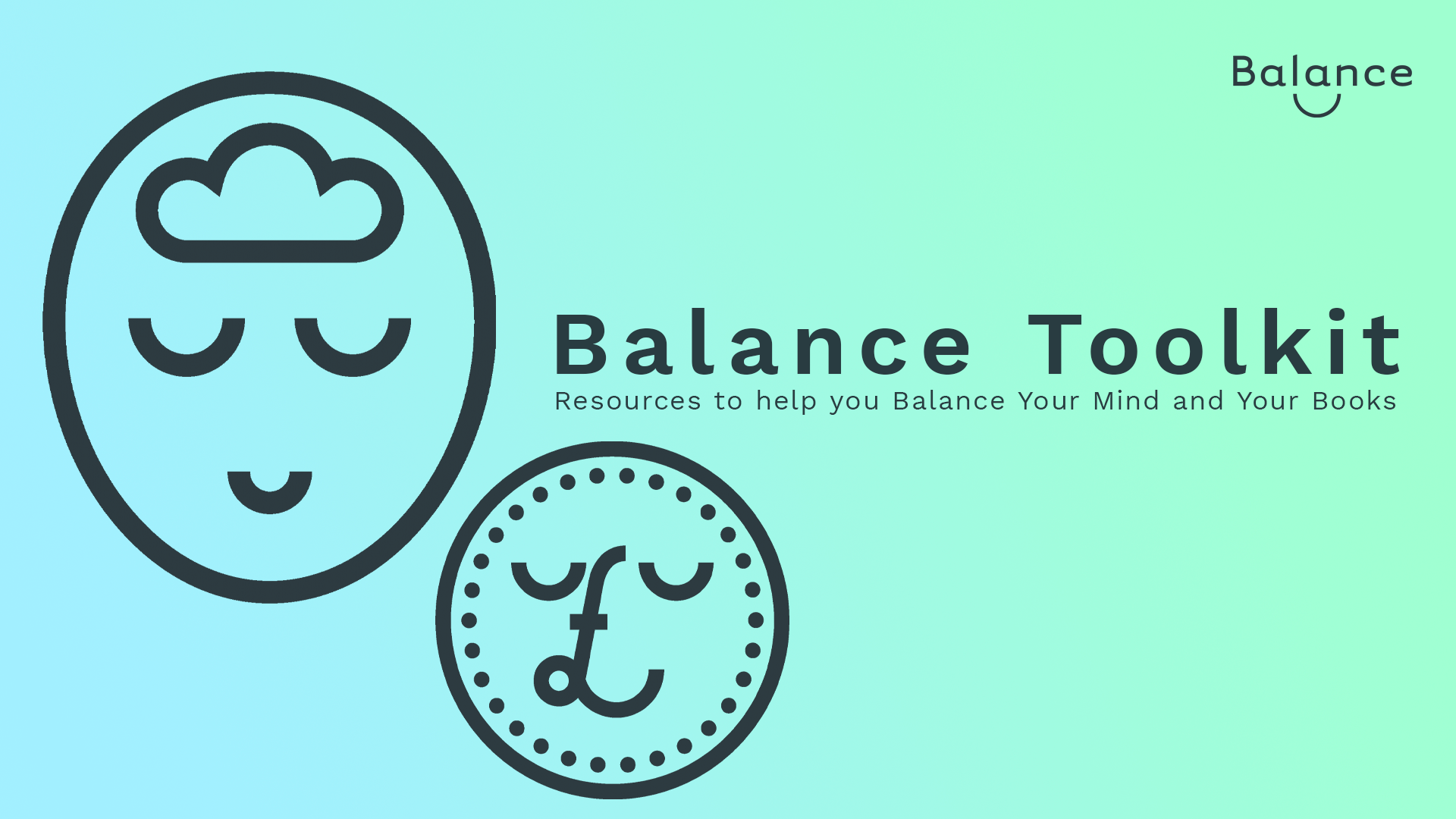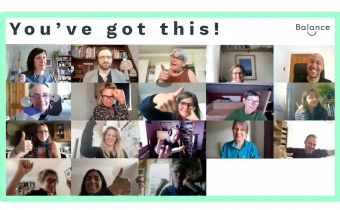Tackling anxiety as a creative entrepreneur: tips from a (semi!) reformed worrier
Everyone feels anxious from time to time; it’s just part and parcel of being human. But for creative freelancers and entrepreneurs, it can often feel like anxiety is the major clause in a contract we unwittingly signed with ourselves the day we decided to take the self-employment path. So, with the theme of this year’s Mental Health Awareness Week being ‘anxiety’, Julia’s sharing some thoughts and insights on what helps her wrestle her anxiety gremlins to the ground.
“Anxiety was born in the very same moment as mankind. And since we will never be able to master it, we will have to learn to live with it— just as we have learned to live with storms.”
Paulo Coelho
It’s really easy for me to trace a line from the 10 year old me who experienced crippling anxiety around exams and the adult me – a creative entrepreneur who has to work hard to keep in check her workaholic tendencies. Over the 20-something years I’ve run the hub I’ve learnt a lot, about running said business, about life, about myself and about the shockingly high rates of mental illness amongst those of us who work in the creative sector.
Even before the pandemic, working in the creative sector wasn’t great for our mental health. Whilst 1 in 4 people in the UK will typically experience a mental health issue each year, Inspire’s 2018 research showed that for those of us working in the creative sector the likelihood of doing so was 3 times greater, with anxiety and depression the most common disorders. Fast forward to the pandemic, and research we carried out demonstrated just how severe its impact was on the mental health of those working in the creative sector. Amongst those we surveyed in late 2020 and summer 2021, 8 out of 10 reported Covid 19 had made their mental health worse – compared to 2/3 of adults more generally across the UK – with increased anxiety, feelings of overwhelm, stress and sadness all reported by more than 2/3 of respondents. Our research also suggested that their mental health had worsened by 23% on average (compared to 8% across the UK’s adult population.) [1] Fast forward again, and the impact of the cost of living crisis and Brexit are compounding financial pressures we were already facing through being the last sector to re-open post-pandemic. The result? On a personal level, the majority of people I know who work in the sector are experiencing unsustainable levels of stress and anxiety, while more widely, people in their thousands have left the sector having found a better way to live. Spring 2023 is tough, no?
My top tips for tackling anxiety
Luckily, over the 20 years or so I’ve been doing this stuff, I’ve also learned a fair bit about what makes me anxious, and – crucially – how to keep (for the most part) my worries under control. And it’s these insights that I thought it might be useful to share this Mental Health Awareness Week. We’re all wired differently, and what makes you anxious will be different to what keeps me awake at night, but I’ve learnt from our Balance community that many of us find the same things helpful when tackling anxiety. So, I hope you’ll find something here that will help beat your worry gremlins!
Choose curiosity over fear

“Anxiety is when the butterflies in your stomach turn into bees.”
Brigett Devoue
Curiosity is one of the hub’s core values, and something I try to bring to all of my work. A few years ago I had a lightbulb moment, when I realised that curiosity and fear are two sides of the same coin. When faced with a perceived threat, we can either respond with curiosity (“I don’t know how we’ll do this…Interesting…What might the possibilities be?”) or with fear (“I don’t know how we’ll do this. Oh no! I’m going fail.”). This was a real revelation to me, and now, whenever I feel anxious about something, I try to bring curiosity rather than fear to the mix.
Get better acquainted with your thoughts

“The best use of creativity is imagination. The worst…is anxiety.”
Deepak Chopra
Our brains are hard at work all the time; research suggests that we have 60-70,000 thoughts every day. As creative entrepreneurs, our minds are capable of imagining all kinds of things, good and bad; that’s one of our real strengths, right?! It took me a while to realise that when – just like The Queen in Alice in Wonderland – you can “imagine as many as 6 impossible things before breakfast”, the trick is to be selective about which thoughts you listen to, and recognise they are merely thoughts and NOT FACTS! Now when I find myself falling into negative thinking, I do my best to challenge my thoughts and ask myself if they are actually true or just something my inner critic (called Brenda, as some of you will know!) has conjured up.
I call this my ’SOS moment’, because it’s about Standing back, Observing and Steering myself in the right direction. Part of the observing is sometimes about asking myself what the worst that could happen really is (as opposed to listening to Brenda’s take on that). Meanwhile, the steering element means I’m focusing more on what I can actually control; super helpful for worriers as we waste lots of time and energy on stuff beyond our control.
Key to this is being able to reflect on my thoughts – finding the space to properly explore them, to expand on them or to challenge them. For me, journalling helps me with this; just spending time scribbling things down, having a conversation with myself on paper really helps. (And – guilty pleasure alert – it’s a great way to justify spending money on lovely stationary!)
Why don’t you go do something less boring instead?
 Moving from fever pitch anxiety to moments of calm reflection can be tricky. But sometimes it can really help to just distract yourself and interrupt the worry. Suggestions from our Balance community for so-called ‘circuit breakers’ range from doing a 5 minute micro-blitz/clean to jumping up and down on a bouncy chair, a mini kitchen disco, going for a walk… or even shoe shopping! There also some well-known grounding techniques, such as the 5-4-3-2-1 exercise you’ll find in our Balance toolkit. Whatever takes your fancy, anything that interrupts that unhelpful train of thought should work a treat.
Moving from fever pitch anxiety to moments of calm reflection can be tricky. But sometimes it can really help to just distract yourself and interrupt the worry. Suggestions from our Balance community for so-called ‘circuit breakers’ range from doing a 5 minute micro-blitz/clean to jumping up and down on a bouncy chair, a mini kitchen disco, going for a walk… or even shoe shopping! There also some well-known grounding techniques, such as the 5-4-3-2-1 exercise you’ll find in our Balance toolkit. Whatever takes your fancy, anything that interrupts that unhelpful train of thought should work a treat.
Stay in the now and schedule some worry time
 One thing that I sometimes find useful is bringing myself back to the now, to the present. Sometimes when the worries persist, I find it can be really effective to just ask myself, “What’s happening right now?”, “Am I safe?”, “Is there something I really need to do about this right now?” If there is, I’ll do something to interrupt the worry (see above) to ‘reset’ my mind. If there isn’t, I put a time in my diary later in the week/month to revisit that particular worry and take some action when I’m calmer. Doing either seems to provide a bit of a ‘reset’, and gives me permission to move on with my day as best I can, knowing that I’ve got things covered.
One thing that I sometimes find useful is bringing myself back to the now, to the present. Sometimes when the worries persist, I find it can be really effective to just ask myself, “What’s happening right now?”, “Am I safe?”, “Is there something I really need to do about this right now?” If there is, I’ll do something to interrupt the worry (see above) to ‘reset’ my mind. If there isn’t, I put a time in my diary later in the week/month to revisit that particular worry and take some action when I’m calmer. Doing either seems to provide a bit of a ‘reset’, and gives me permission to move on with my day as best I can, knowing that I’ve got things covered.
Say hello to the 5×5 rule!

The 5×5 rule is one of my favourite anxiety busting tools! This really simple rule states that when you’re feeling anxious you simply take a moment to reflect on whether or not the thing you’re worrying about will matter in 5 years. If the answer is yes, then you should schedule some time to come up with a strategy to address it (see above!). But, if the answer is no, then you allow yourself just 5 minutes to worry about it, before moving on. If you can play by this rule, it’s a brilliant way to break out of a worry spiral!
I will survive! And be the smarter for it

“The greatest mistake we make is living in constant fear that we will make one.”
John C. Maxwell
When times are tough and you’re feeling super anxious, there are worse things you could do than put your trust in the Gospel of Gloria: “I will survive”. Thinking back to times when I’ve tackled problems before can sometimes be just the thing to soothe my anxiety. I’ve realised that, most of the time, we’re more resilient than our worries give us credit for.
Kill worry with kindness and treat yourself as you would a friend
 Anxiety is rooted in fear, and in my experience the best way to respond to fear is with kindness. When you’re anxious, try showing yourself the kindness you’d show your best friend if they came to you with a worry. Whether that’s seeing off a noisy inner critic, parking the worry and getting yourself some tea and cake (actually, thinking about it, tea and cake should be on this list in their own right!) or going for a run, above all you need to be kind to yourself.
Anxiety is rooted in fear, and in my experience the best way to respond to fear is with kindness. When you’re anxious, try showing yourself the kindness you’d show your best friend if they came to you with a worry. Whether that’s seeing off a noisy inner critic, parking the worry and getting yourself some tea and cake (actually, thinking about it, tea and cake should be on this list in their own right!) or going for a run, above all you need to be kind to yourself.
And while we’re talking about treating yourself as you would a friend, I also find it helpful to ask myself what advice I’d give to a friend in this situation. Even if the solution I come up with isn’t quite right for me, it helps me reset my mind into a more rational state, and before I know it I’ve had my own lightbulb moment and moved on.
Reach out to a friend
 The saying goes that “a problem shared is a problem halved”, and one of the best ways I know to calm my worried mind is to reach out to a trusted friend or colleague. What I need from the conversation might differ from one situation/person to another; sometimes it’s advice, sometimes I need help finding the answer myself, sometimes it’s empathy and reassurance, or even just distracting! Just saying things out loud can really sharpen my clarity, as if I’m hearing myself for the first time. So, go on, phone a friend and give your worries an airing!
The saying goes that “a problem shared is a problem halved”, and one of the best ways I know to calm my worried mind is to reach out to a trusted friend or colleague. What I need from the conversation might differ from one situation/person to another; sometimes it’s advice, sometimes I need help finding the answer myself, sometimes it’s empathy and reassurance, or even just distracting! Just saying things out loud can really sharpen my clarity, as if I’m hearing myself for the first time. So, go on, phone a friend and give your worries an airing!
Just breathe!
 We all know that deep breathing helps us calm down. But what, if like me, you worry that you’re ‘not doing it right’?! There are so many books about breathing (a good number of which are languishing half-read on my bookshelves)! The good news is that in moments of anxiety you don’t need to worry about counting out a certain number of breaths. Instead, just focus on evenly inhaling and exhaling. Trust me, and join me in abandoning the counting!
We all know that deep breathing helps us calm down. But what, if like me, you worry that you’re ‘not doing it right’?! There are so many books about breathing (a good number of which are languishing half-read on my bookshelves)! The good news is that in moments of anxiety you don’t need to worry about counting out a certain number of breaths. Instead, just focus on evenly inhaling and exhaling. Trust me, and join me in abandoning the counting!
Preventation is better than a cure
So, we’ve looked at a few of my favourite ‘go tos’ for easing moments of anxiety, but I also wanted to share a few thoughts on what helps me avoid such moments in the first place.
Setting clear boundaries
 A big source of anxiety for lots of the creative freelancers I work with is not having clear (and clearly communicated) boundaries – with themselves and with their clients. In response, one thing I often ask them to do is make a ‘manual of me’: a record of things like how they like to work, what fuels or drains their energy, what inspires them and what makes them anxious (see this lovely website for inspiration). Doing this can really help set boundaries; it’s both a personal reflection tool AND the basis for a manifesto/set of T&Cs you can set out to prospective clients.
A big source of anxiety for lots of the creative freelancers I work with is not having clear (and clearly communicated) boundaries – with themselves and with their clients. In response, one thing I often ask them to do is make a ‘manual of me’: a record of things like how they like to work, what fuels or drains their energy, what inspires them and what makes them anxious (see this lovely website for inspiration). Doing this can really help set boundaries; it’s both a personal reflection tool AND the basis for a manifesto/set of T&Cs you can set out to prospective clients.
Being a good employer of myself
 I’m slightly embarrassed that it’s only in the last few years that I’ve realised a key part of being successfully self-employed is to be a good employer of myself. For years, I employed myself in a way that if anyone else had done so, I would have quit straight away! This changed a few years ago when, towards the end of a sabbatical, I wrote some ‘returning to work guidelines’ for myself. Knowing that a simple list of changes to make wouldn’t work, I wrote about Julia as my employee, developing a code of conduct for how I employed her that I eventually distilled into ‘KNEES’, an acronym of sorts about how work should be: Kind (to me); Nurturing; Exciting; Enough (but not too much), and Sustainable. Having this has helped curb some of the tendencies that fed my anxiety.
I’m slightly embarrassed that it’s only in the last few years that I’ve realised a key part of being successfully self-employed is to be a good employer of myself. For years, I employed myself in a way that if anyone else had done so, I would have quit straight away! This changed a few years ago when, towards the end of a sabbatical, I wrote some ‘returning to work guidelines’ for myself. Knowing that a simple list of changes to make wouldn’t work, I wrote about Julia as my employee, developing a code of conduct for how I employed her that I eventually distilled into ‘KNEES’, an acronym of sorts about how work should be: Kind (to me); Nurturing; Exciting; Enough (but not too much), and Sustainable. Having this has helped curb some of the tendencies that fed my anxiety.
Investing time and effort in balancing my mind
 When you’re self-employed YOU are your biggest asset, and yet all too often looking after ourselves falls to the bottom of our to do list. That way lies anxiety, depression, burnout and a business and way of life that no one would choose. As employers of ourselves, we need to put nurturing our minds at the top of our to do lists. If you do just one thing as a result of reading this blog, make it this! And as starter for 10, you could of course do worse than head over to our entirely free to use Balance toolkit, designed specifically to help creative entrepreneurs balance their minds AND their books, or catch up on our Balance talks here.
When you’re self-employed YOU are your biggest asset, and yet all too often looking after ourselves falls to the bottom of our to do list. That way lies anxiety, depression, burnout and a business and way of life that no one would choose. As employers of ourselves, we need to put nurturing our minds at the top of our to do lists. If you do just one thing as a result of reading this blog, make it this! And as starter for 10, you could of course do worse than head over to our entirely free to use Balance toolkit, designed specifically to help creative entrepreneurs balance their minds AND their books, or catch up on our Balance talks here.




